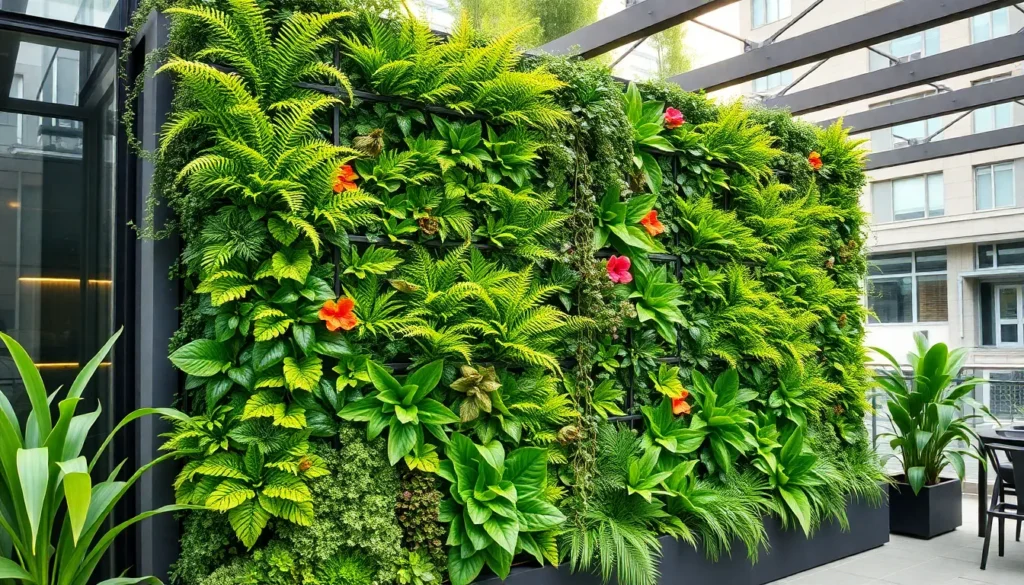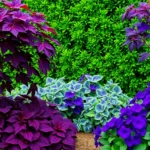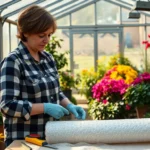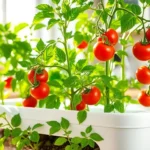We’ve all dreamed of having that perfect garden – lush greenery year-round without the endless watering, weeding, and worrying about weather conditions. That’s where artificial gardens come to the rescue, offering stunning visual appeal with zero maintenance headaches.
Modern artificial plants and landscaping materials have come a long way from the obviously fake options of the past. Today’s synthetic alternatives look incredibly realistic and can transform any space into a beautiful green oasis that stays gorgeous in every season. Whether you’re dealing with challenging growing conditions, lack of time, or simply want to enjoy nature’s beauty without the work, artificial gardens provide the perfect solution.
From rooftop terraces to indoor spaces and traditional outdoor areas, we’ll explore creative artificial garden ideas that’ll make your neighbors wonder how you maintain such pristine landscaping. Get ready to discover low-maintenance answers that deliver maximum impact for your home or business.
Create a Stunning Vertical Artificial Garden Wall
Vertical artificial garden walls transform blank surfaces into breathtaking focal points that bring life to any space. These living wall installations offer the perfect blend of natural beauty and practical convenience for busy homeowners.
Choose the Right Artificial Plants for Your Wall
Selecting premium quality artificial plants makes the difference between a stunning wall and an obvious fake display. We recommend focusing on plants with varied leaf sizes and natural color variations to create authentic appeal.
Ferns and foliage plants work exceptionally well as base layers because they provide lush green coverage. Boston ferns, maidenhair ferns, and eucalyptus varieties create excellent foundational elements that mimic real growing patterns.
Flowering plants add pops of color and seasonal interest throughout the year. Consider artificial orchids, roses, or trailing petunias that maintain their vibrant appearance without watering or pruning requirements.
Textural elements like artificial moss, succulents, and air plants introduce dimensional contrast. These materials help break up solid green areas while adding realistic growing variations that catch the eye naturally.
| Plant Type | Best Placement | Visual Impact |
|---|---|---|
| Large ferns | Bottom third of wall | Creates natural foundation |
| Flowering vines | Cascading downward | Adds movement and color |
| Small succulents | Scattered throughout | Provides texture variety |
| Moss patches | Between larger plants | Fills gaps naturally |
Install Proper Mounting Systems and Frameworks
Strong mounting systems ensure your vertical garden remains secure and maintains its beautiful appearance over time. We suggest starting with a sturdy framework that can support the weight of multiple plants and their containers.
Grid systems offer the most flexibility for arrangement changes and seasonal updates. Metal or plastic grid panels attach directly to walls and accommodate various pot sizes and hanging mechanisms.
Pocket planters create seamless installations that appear more integrated than individual containers. These fabric or plastic systems feature multiple planting pockets that hold artificial plants securely while maintaining proper spacing.
Modular panels provide professional looking results with minimal installation complexity. Pre designed sections snap together to cover large areas while ensuring consistent plant placement and visual flow.
Wall anchors and brackets must match your wall type and support the total weight capacity. Drywall installations require heavy duty anchors, while concrete or brick walls need masonry fasteners for maximum security.
Layer Different Textures and Colors for Visual Interest
Strategic layering creates depth and prevents flat, artificial appearances that give away fake installations. We build successful vertical gardens by combining multiple plant heights, leaf shapes, and color tones.
Background layers establish the foundation using larger plants with broad leaves. Place these elements first to create a solid base that other plants can build upon naturally.
Middle layers introduce medium sized plants that fill gaps and provide transition zones. Trailing varieties work particularly well in these positions because they soften harsh edges between different plant types.
Foreground accents feature the most eye catching plants that draw attention and create focal points. Brightly colored flowers, unique leaf patterns, or unusual plant shapes work best in these prominent positions.
Color coordination follows natural growing patterns where similar tones cluster together gradually. Start with predominantly green areas then introduce colorful plants in organic groupings that mimic real garden distributions.
Texture mixing combines smooth leaves with rough bark, delicate flowers with sturdy stems, and fine foliage with bold architectural plants. This variety prevents monotony while maintaining realistic growing relationships between different species.
Design a Low-Maintenance Artificial Herb Garden
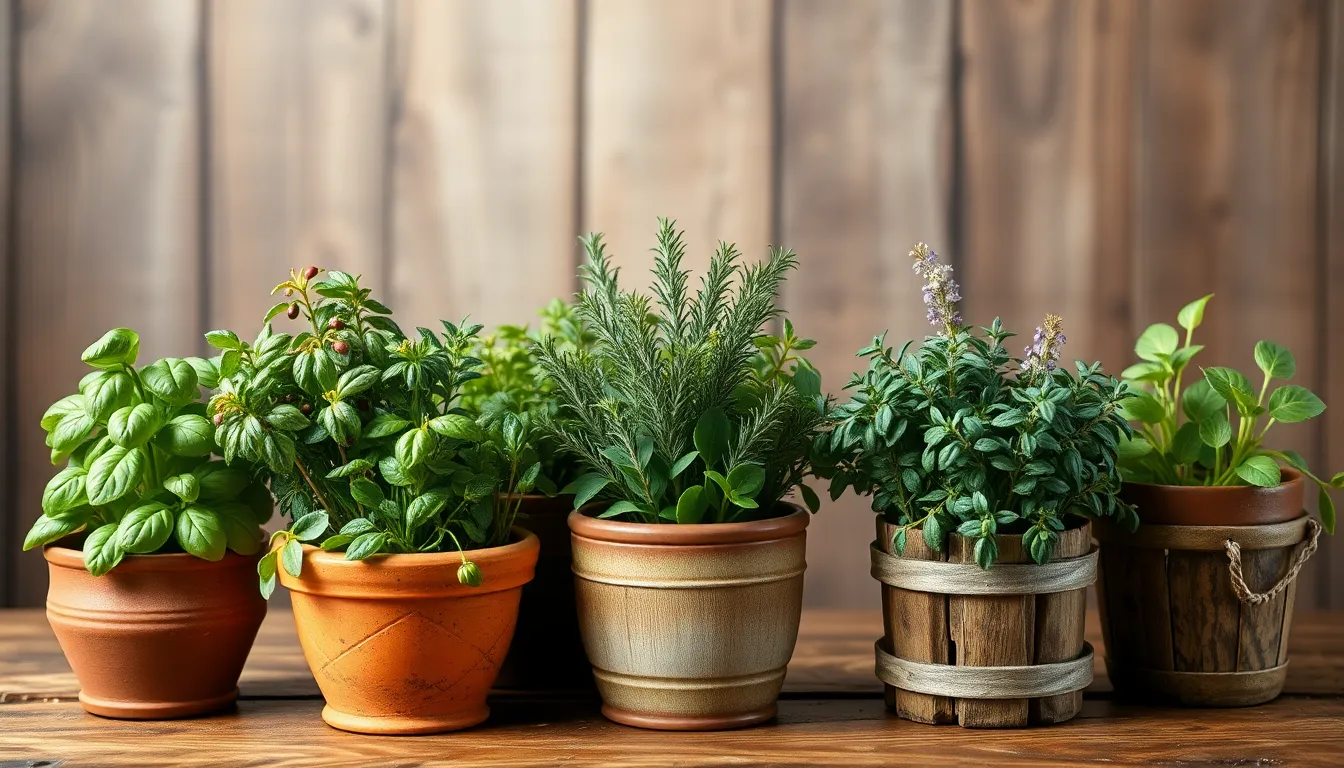
Artificial herb gardens offer the perfect solution for busy homeowners who want fresh-looking herbs without the daily watering and maintenance. We’ll show you how to create a stunning display that brings the beauty of an herb garden indoors or outdoors.
Select Realistic Artificial Herbs for Your Kitchen
Quality matters when choosing artificial herbs that’ll fool even experienced gardeners. We recommend selecting high-quality replicas of popular herbs like basil, rosemary, and thyme that feature realistic textures and natural color variations. Modern artificial herbs now include detailed vein patterns on leaves and authentic-looking stems that closely mimic their living counterparts.
Durability becomes crucial since these herbs need to withstand various lighting conditions without fading over time. We suggest testing artificial herbs under different light sources before purchasing to ensure they maintain their vibrant appearance. UV-resistant materials work best for outdoor displays while standard quality works perfectly for indoor arrangements.
Popular Artificial Herb Options:
| Herb Type | Best Features | Recommended Use |
|---|---|---|
| Basil | Glossy leaves with realistic texture | Kitchen windowsills |
| Rosemary | Needle-like leaves with woody stems | Outdoor planters |
| Thyme | Small delicate leaves | Mixed arrangements |
| Oregano | Fuzzy leaf texture | Mediterranean themes |
Arrange Herbs in Vintage Containers and Planters
Vintage containers transform artificial herbs into charming focal points that enhance any space’s aesthetic appeal. We love using old terracotta pots because their weathered surfaces add authentic character to artificial displays. Wooden planters work beautifully for rustic themes while metal containers create industrial or farmhouse vibes.
Grouping different sized containers creates visual interest and prevents monotonous arrangements. We recommend placing taller herbs like rosemary in larger pots while using smaller containers for compact herbs like thyme. Mixing container materials and heights adds depth to your artificial herb garden display.
Drainage holes aren’t necessary for artificial plants but including decorative stones or moss at the bottom creates a more realistic appearance. We often add a layer of artificial soil or bark chips to complete the authentic look.
Add Decorative Labels and Garden Markers
Labels serve both functional and decorative purposes in artificial herb gardens by adding authenticity to your display. We prefer using weathered wooden stakes or vintage-style metal markers that complement the overall garden theme. Hand-lettered labels on rustic materials create a personalized touch that guests will admire.
Positioning labels correctly enhances the visual flow of your arrangement without overwhelming the herbs themselves. We suggest placing markers at slight angles rather than perfectly straight to mimic natural garden settings. Chalkboard labels offer flexibility since you can change herb names or add decorative quotes seasonally.
Creative Label Ideas:
- Wooden stakes with burned lettering
- Vintage spoon markers with stamped names
- Small chalkboards on easel stands
- Stone markers with painted text
- Metal plant tags with weathered finishes
Combining artificial herbs with real plants creates a blended look that adds surprising depth to your garden display. We often mix artificial herbs with live succulents or small potted plants to create texture variations that fool the eye.
Build an Indoor Artificial Succulent Display
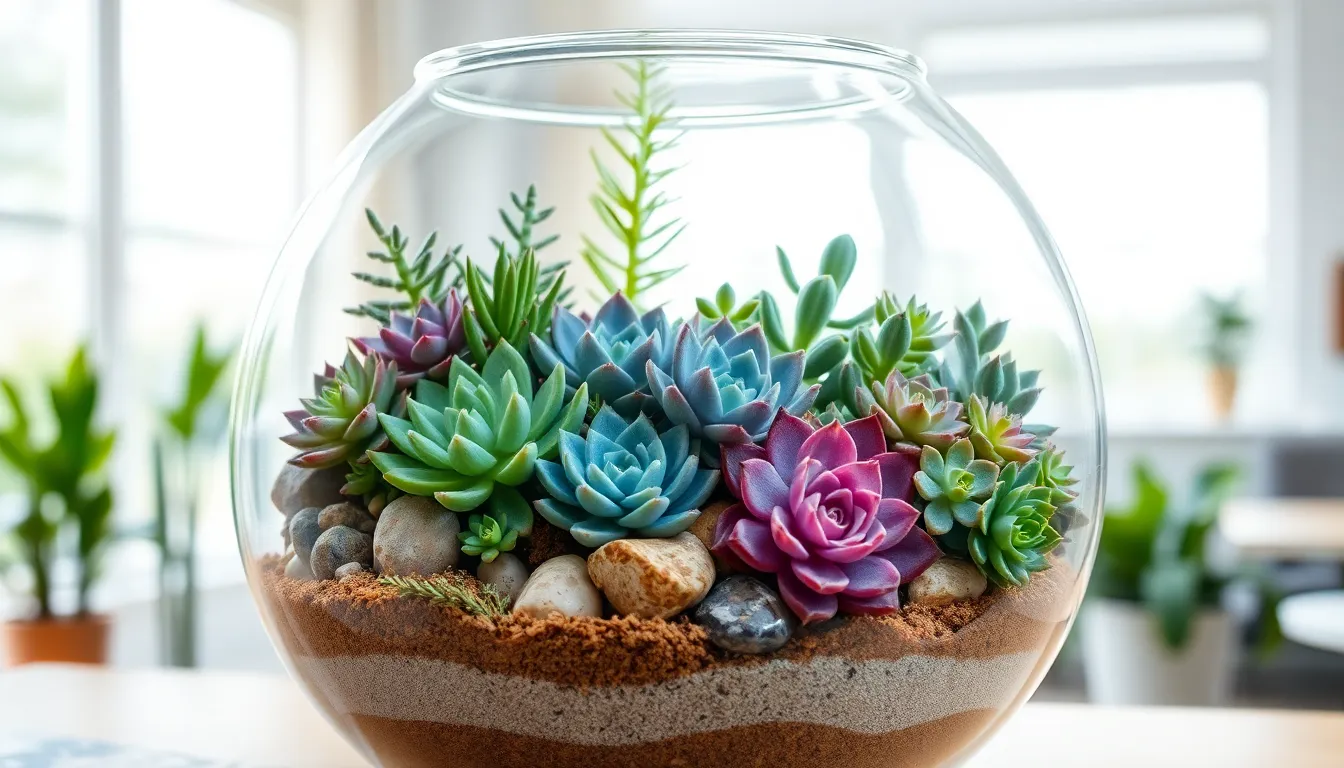
Indoor artificial succulent displays offer perfect answers for creating stunning botanical focal points without watering schedules or lighting concerns. We’ll show you how to create arrangements that capture the natural beauty of desert gardens while maintaining year-round visual appeal.
Mix Various Artificial Succulent Varieties
Choose diverse shapes and sizes to create authentic looking displays that mirror natural succulent gardens. Rosette type succulents like artificial echeveria and sempervivum provide classic structural elements, while trailing varieties such as string of pearls and burro’s tail add cascading movement to arrangements.
Color palette selection transforms ordinary displays into captivating centerpieces using natural variations found in real succulent species. We recommend mixing greens, blues, and purples to simulate the authentic color range that makes succulent gardens so visually striking. Burgundy and silver toned varieties add sophisticated contrast that prevents monotonous green arrangements.
Texture combinations enhance realism when we pair smooth jade plant replicas with fuzzy lamb’s ear succulents and spiky aloe varieties. Different leaf shapes create visual interest that keeps viewers engaged while mimicking the natural diversity found in desert environments.
Create Eye-Catching Arrangements in Glass Terrariums
Glass containers provide ideal settings for artificial succulent displays because they create mini indoor gardens with clear viewing angles from all sides. We prefer using geometric terrariums, hanging glass orbs, and vintage apothecary jars that showcase arrangements while protecting them from dust accumulation.
Layering techniques establish proper visual foundation starting with small rocks or pebbles at the bottom for drainage simulation. Sand or decorative stones form the next layer, followed by activated charcoal if desired, then a final layer of specialized terrarium soil or colored sand that complements your succulent selection.
Strategic placement maximizes visual impact when we position larger statement succulents as focal points while filling gaps with smaller varieties. Asymmetrical arrangements look more natural than perfectly centered displays, so we recommend using the rule of thirds for balanced compositions.
Incorporate Natural Elements Like Stones and Sand
Decorative stones enhance authenticity by creating natural looking environments around artificial succulents while adding textural contrast. River rocks, lava stones, and polished pebbles work exceptionally well because they mimic the rocky conditions where real succulents thrive naturally.
Sand varieties provide realistic ground cover that transforms basic displays into desert inspired landscapes. Colored sand layers create striking visual effects, while natural beach sand offers subtle backgrounds that don’t compete with succulent colors. We’ve found that mixing different sand textures adds depth and prevents flat appearances.
Additional texture elements elevate displays beyond basic arrangements using pinecones, small branches, or driftwood pieces that add organic interest. These natural additions create realistic habitats while providing height variations that make arrangements more ever-changing and visually captivating.
Lighting considerations complete professional looking displays when we place them in areas with bright, indirect light that creates realistic ambiance without causing color fading. LED strip lights or small spotlights can highlight exact arrangements during evening hours for dramatic effect.
Establish an Artificial Flower Garden Border
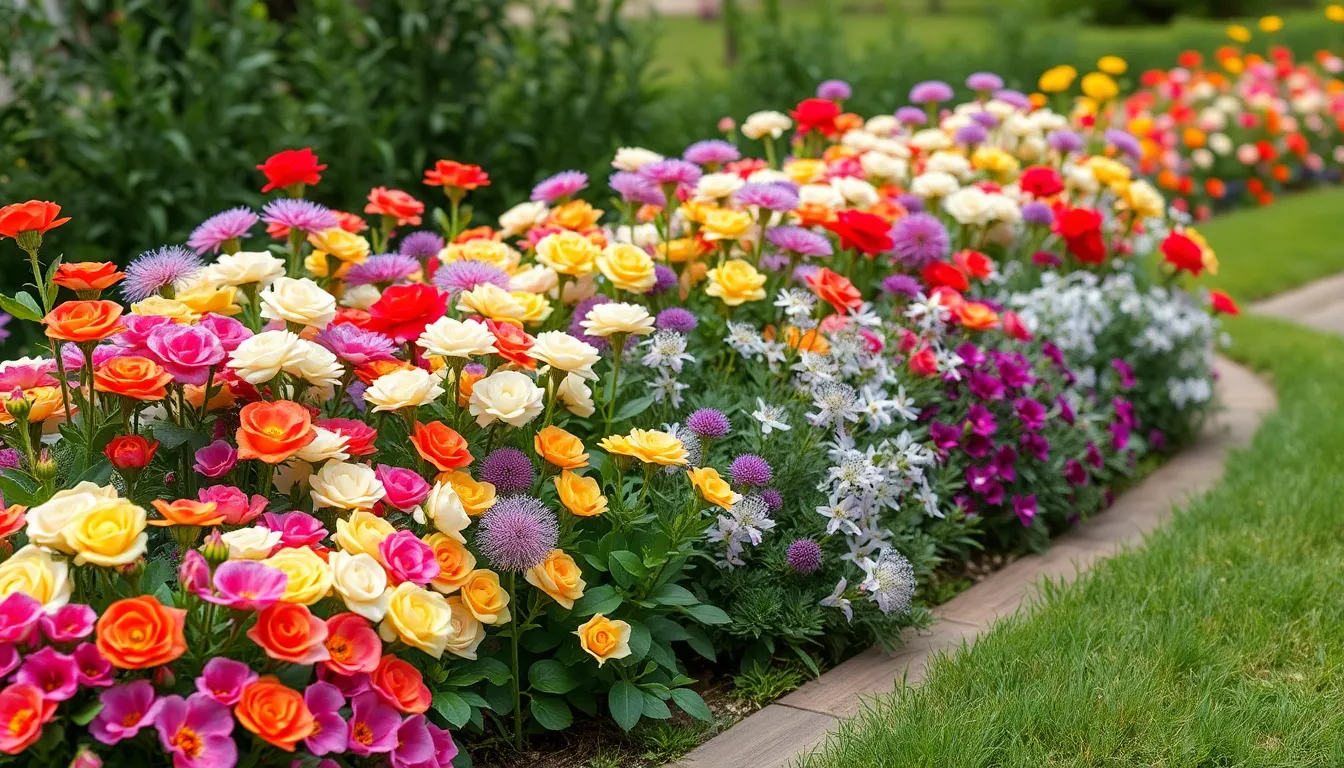
Creating an artificial flower garden border transforms ordinary pathways and entrances into vibrant focal points that welcome guests year-round. We’ll show you how to design stunning borders using strategic planning, quality materials, and natural arrangement techniques.
Plan Your Artificial Flower Color Scheme
Selecting the right color palette ensures your artificial flower border complements your outdoor decor seamlessly. We recommend choosing colors that harmonize with your home’s exterior and existing industry elements like fencing, stonework, or natural vegetation.
Consider these proven color approaches for maximum visual impact:
- Pastel combinations create soft, serene atmospheres perfect for cottage-style gardens
- Vibrant color mixes add energy and vitality to modern industry designs
- Monochromatic schemes offer sophisticated elegance using varying shades of single colors
- Complementary pairings like purple and yellow create striking visual contrast
Study your surroundings during different times of day to understand how natural light affects color perception. Artificial roses, azaleas, and alliums work exceptionally well as border flowers because they maintain consistent coloring throughout seasons.
Choose Weather-Resistant Artificial Blooms
Quality materials make the difference between artificial flowers that last years versus those that fade within months. We prioritize selecting blooms specifically designed to withstand outdoor conditions including rain, intense sun exposure, and temperature fluctuations.
Look for these essential weather-resistant features:
| Feature | Benefit | Recommended Materials |
|---|---|---|
| UV Protection | Prevents color fading | PE plastic, silk blends |
| Water Resistance | Stops mold growth | Polyethylene, treated fabrics |
| Fade Resistance | Maintains vibrant colors | High-grade synthetic materials |
| Temperature Stability | Prevents cracking | Flexible polymer blends |
Premium artificial flowers use advanced manufacturing techniques that create realistic textures while maintaining durability. We’ve found that investing in higher-quality weather-resistant blooms saves money long-term by eliminating frequent replacements.
Create Natural-Looking Planting Patterns
Mimicking organic growth patterns makes artificial flower borders appear authentically natural rather than obviously manufactured. We arrange flowers using varying heights, textures, and spacing that replicate how plants naturally establish themselves in garden settings.
Follow these natural planting principles:
Height Variation: Place taller artificial flowers like roses toward the back, medium-height blooms like azaleas in the middle, and shorter options like alliums along the front edge.
Texture Mixing: Combine different leaf shapes and flower forms to create visual depth. Incorporate artificial greenery like ferns and vines between flowering plants for realistic layering.
Irregular Spacing: Avoid perfectly uniform distances between plants. Nature creates clusters, gaps, and organic arrangements that we replicate using intentional irregularity.
Container Strategy: Use planters, containers, and trellises at different levels to add architectural interest. Mix various container sizes and materials to enhance the natural, collected-over-time appearance.
Successful artificial flower borders blend seamlessly with surrounding landscapes by following these organic principles while providing consistent beauty without maintenance requirements.
Construct a Miniature Artificial Fairy Garden
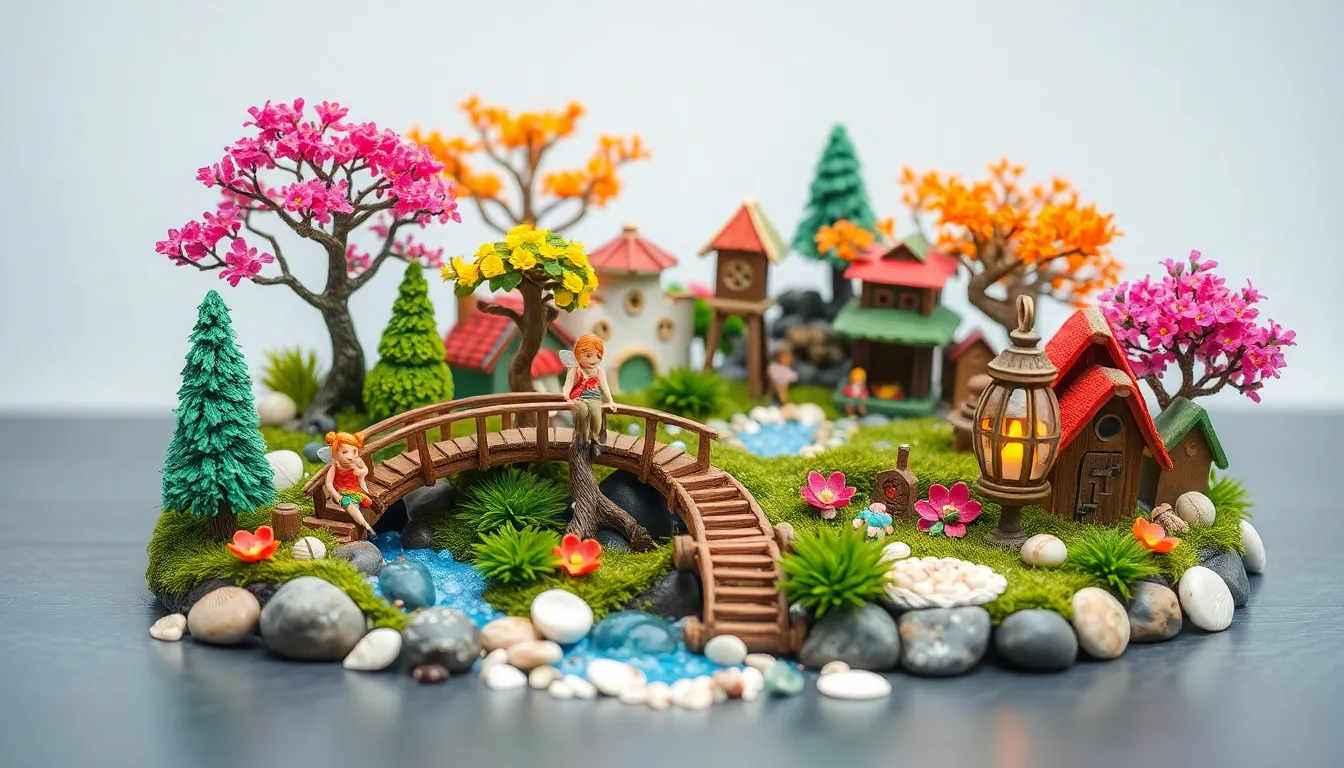
Creating miniature artificial fairy gardens opens up endless possibilities for magical storytelling in compact spaces. These enchanting displays bring whimsy to any indoor or outdoor area while requiring zero maintenance.
Design Whimsical Themes and Storylines
Theme selection forms the foundation of every successful fairy garden project. Beach-inspired scenes transport viewers to coastal wonderlands with sandy pathways and seashell accents. Forest themes create mystical woodland settings using miniature trees and moss-covered elements. Paris-inspired gardens evoke European charm through tiny Eiffel Tower replicas and vintage café furniture.
Storytelling elements breathe life into your miniature industry through carefully chosen props. Miniature houses serve as fairy dwellings, while tiny bridges connect different garden areas. Character figurines like fairies, gnomes, and woodland creatures populate your scenes with personality. Pathways guide the eye through your narrative, creating journey-like experiences for viewers.
Add Miniature Accessories and Decorative Elements
Miniature decor adds authentic texture and visual interest to fairy garden landscapes. Small shells create coastal atmospheres, while pebbles form natural-looking pathways and water features. Mini pine cones bring forest elements indoors, and acorns add seasonal woodland touches. Decorative gravel replaces traditional soil, providing clean drainage answers.
Themed accessories enhance your garden’s narrative through purposeful prop selection. Tiny furniture pieces like benches and tables create gathering spaces for fairy inhabitants. Miniature sculptures add artistic focal points throughout the display. Small lanterns and fairy lights provide magical illumination effects. Vintage-style signs and markers guide visitors through your fairy tale setting.
Position Artificial Plants for Maximum Impact
Strategic plant placement creates visual balance and natural-looking depth in fairy gardens. Taller artificial plants work best as background elements, while shorter varieties fill foreground spaces. Clustering plants in odd numbers mimics organic growth patterns found in nature. Corner placements anchor the design, while scattered mid-sized plants fill transitional areas.
Layering different heights and textures prevents flat, artificial appearances in miniature gardens. Background layers use the tallest artificial foliage to create depth perception. Middle layers incorporate medium-height plants with varied leaf shapes and colors. Foreground elements feature the smallest plants and ground-covering varieties. Texture mixing combines smooth-leafed plants with spiky or fuzzy varieties for authentic visual interest.
Install Artificial Grass for Year-Round Greenery
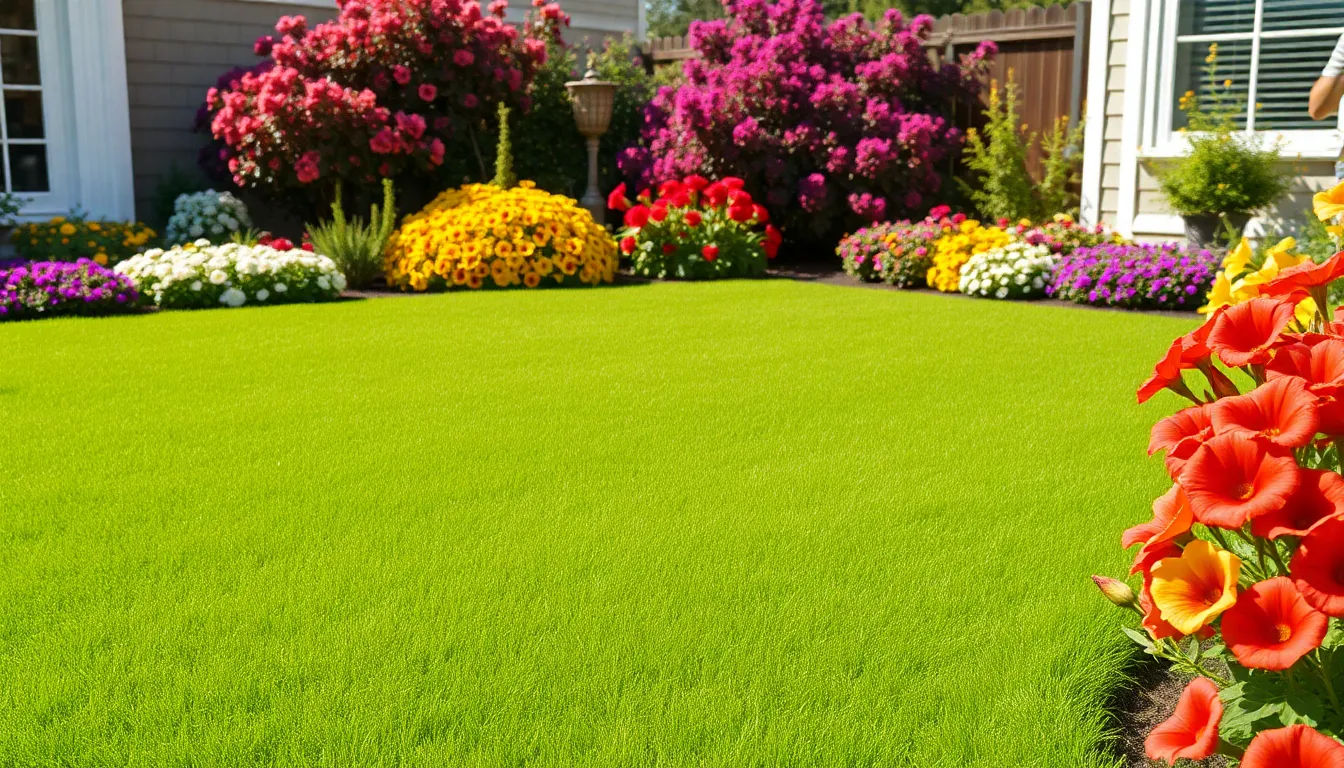
Artificial grass transforms your garden into a perpetually green oasis that requires minimal upkeep compared to traditional lawns. This synthetic solution maintains its vibrant appearance throughout all seasons, eliminating the need for frequent watering, mowing, and fertilizing while providing consistent beauty year-round.
Compare Different Artificial Grass Types and Textures
Different artificial grass varieties offer distinct advantages for exact garden applications and aesthetic preferences. Density and pile height determine how lush and realistic your synthetic lawn appears, with higher density options providing fuller coverage and more natural texture underfoot.
Color and shade variations range from natural green tones that mimic real grass to more vibrant colors for unique design statements. Natural green options blend seamlessly with existing landscaping, while brighter alternatives create bold focal points in contemporary garden designs.
Material composition significantly impacts durability and performance across different weather conditions. Polypropylene offers excellent UV resistance and maintains color vibrancy, polyethylene provides superior softness and natural appearance, while nylon delivers exceptional durability for high-traffic areas.
| Material Type | UV Resistance | Softness Level | Durability Rating | Best Use Case |
|---|---|---|---|---|
| Polypropylene | Excellent | Good | High | Sun-exposed areas |
| Polyethylene | Good | Excellent | Medium | Family spaces |
| Nylon | Good | Medium | Excellent | High-traffic zones |
Prepare Your Space for Professional Installation
Proper preparation ensures your artificial grass installation delivers professional results and long-lasting performance. Removing existing materials involves clearing the designated area of all debris, vegetation, and organic matter that could decompose beneath your new synthetic surface.
Grading and compacting creates the stable foundation essential for preventing future settling or uneven surfaces. We recommend using a plate compactor to achieve optimal base density, ensuring your artificial grass maintains its smooth appearance over time.
Installing weed barriers prevents unwanted vegetation growth that could push through your synthetic turf. Quality industry fabric blocks weeds while allowing proper drainage, protecting your investment and maintaining the pristine appearance of your artificial garden space.
Maintain Your Artificial Lawn for Longevity
Regular maintenance keeps your artificial grass looking fresh and extends its functional lifespan significantly. Regular cleaning involves removing accumulated debris, leaves, and dirt using a leaf blower or gentle rake designed specifically for synthetic surfaces.
Infilling requires periodic addition of specialized materials like silica sand or rubber granules to maintain turf stability and proper drainage. This process typically occurs every 12-18 months depending on usage patterns and environmental conditions in your area.
Brushing prevents matting and maintains the upright position of grass fibers, ensuring your synthetic lawn continues looking natural and well-maintained. Use a stiff brush with synthetic bristles, working against the grain to restore the grass’s original texture and appearance.
Develop a Seasonal Artificial Garden Display
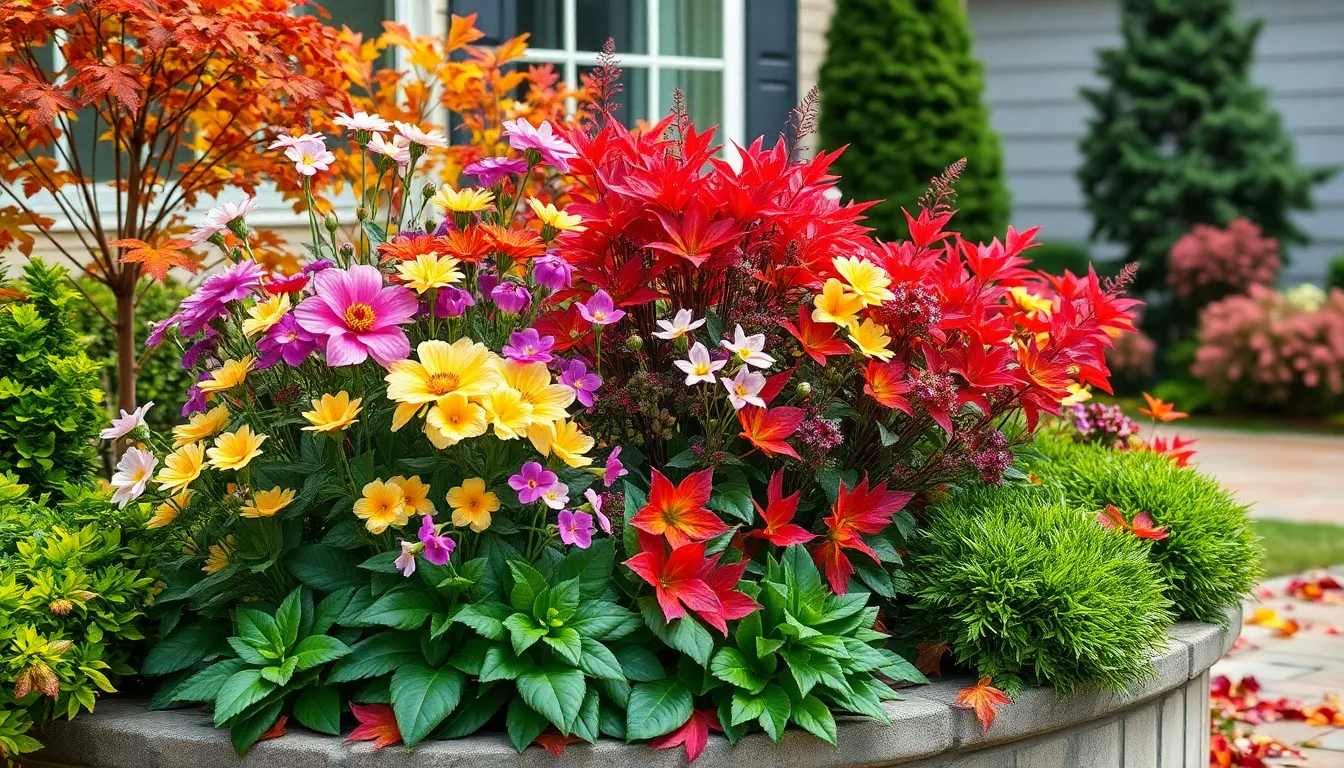
Creating seasonal displays with artificial plants lets us maintain year-round garden beauty while adapting to different times of the year. We’ll explore effective strategies for rotating displays, incorporating festive elements, and storing components properly.
Rotate Artificial Plants for Each Season
Spring and Summer displays flourish with vibrant artificial flowers and lush greenery that capture the season’s energy. Tropical elements like palm trees and hibiscus bring warmth to our outdoor spaces, while pastel-colored plants create that fresh springtime atmosphere we love.
Autumn transformations work best with warm-toned artificial leaves and branches that simulate natural fall foliage. Rich oranges, deep reds, and golden yellows help us recreate the stunning beauty of changing seasons without waiting for nature’s timeline.
Winter arrangements shine when we incorporate frosted or snow-covered artificial plants that create magical winter wonderland effects. These specialized materials maintain their appearance throughout harsh weather conditions, ensuring our displays stay beautiful all season long.
Incorporate Holiday-Themed Decorative Elements
Halloween decorations blend perfectly with spooky-themed artificial plants that create mysterious garden atmospheres. Spider webs, jack-o’-lanterns, and dark foliage combinations transform our spaces into festive focal points that capture the holiday spirit.
Christmas elements combine beautifully when we pair artificial evergreen branches with festive lights and ornaments. These combinations create stunning displays that maintain their fresh appearance throughout the entire holiday season without dropping needles or losing their shape.
Easter celebrations benefit from pastel-colored artificial flowers paired with decorative eggs and spring-themed accessories. Soft pinks, light yellows, and gentle purples help us create cheerful displays that welcome the season’s renewal.
Store Off-Season Artificial Garden Components
Proper cleaning methods ensure our artificial plants maintain their quality during storage periods. We should remove dust and debris before packing components away, which prevents deterioration and keeps materials looking fresh for the next season.
Storage organization works best when we use labeled boxes or containers for easy identification and retrieval. Clear labeling systems help us quickly locate exact seasonal elements when it’s time to rotate our displays, saving valuable time during busy transition periods.
Climate control considerations protect our artificial garden investments by keeping stored components in dry, temperature-stable environments. Moisture and extreme temperatures can damage materials over time, so proper storage conditions extend the lifespan of our seasonal decorations significantly.
Create an Artificial Zen Garden Retreat
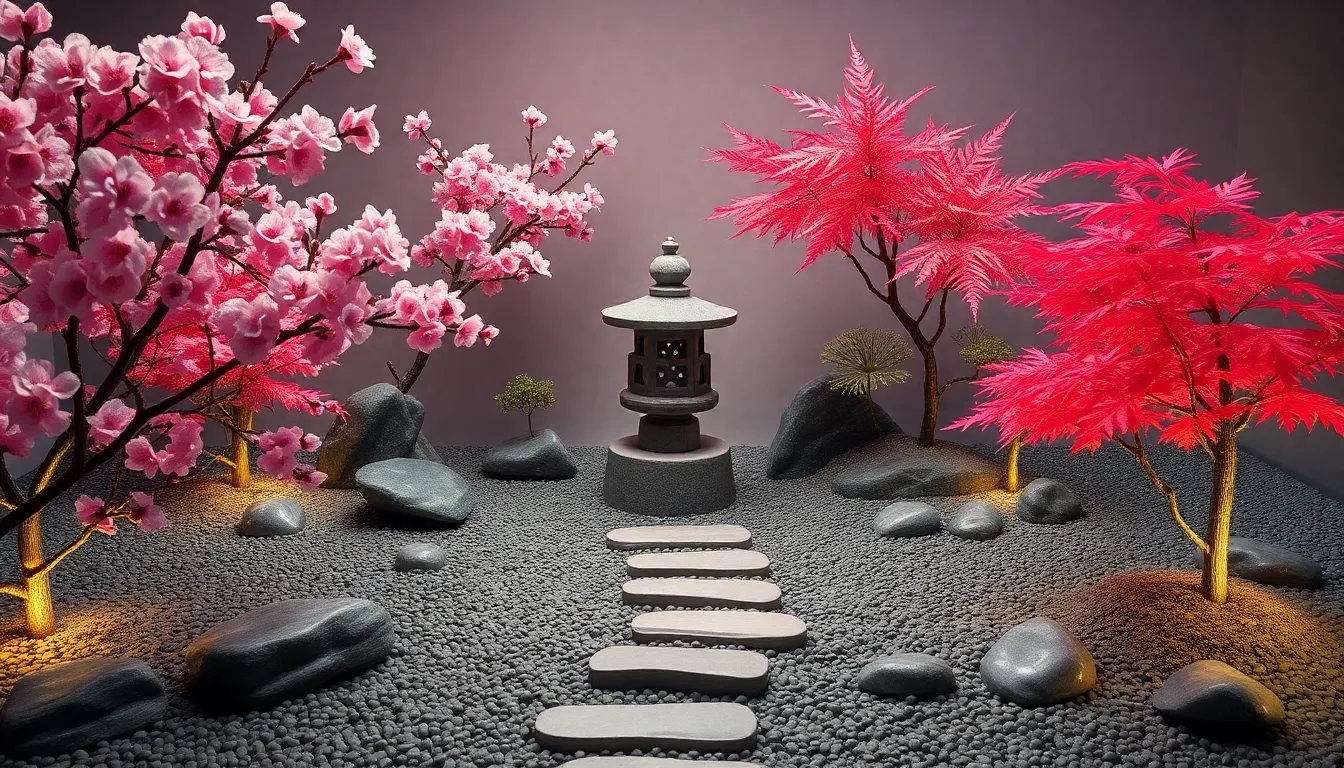
Building upon our previous garden concepts, we can transform any space into a serene sanctuary that promotes mindfulness and tranquility.
Select Minimalist Artificial Plants and Features
Artificial plants form the foundation of your Zen retreat, with minimalist selections that mirror traditional Japanese garden aesthetics. We recommend choosing artificial cherry blossoms or Japanese maple foliage to create that authentic serene atmosphere while maintaining year-round beauty.
Quality features enhance the overall ambiance through simple, natural-looking elements that complement your plant selections. Artificial moss adds texture and authenticity to rock formations, while small decorative stones create visual interest without overwhelming the space’s peaceful nature.
Plant placement should follow minimalist principles, using fewer elements to achieve maximum impact. Strategic positioning of artificial plants creates focal points that draw the eye naturally through the garden space.
Incorporate Peaceful Elements Like Stones and Sand
Stone arrangements serve as the backbone of authentic Zen garden design, with artificial stones and pebbles creating natural-looking formations that promote calm contemplation. We position these elements to resemble organic rock groupings found in traditional Japanese gardens.
Sand patterns add meditative qualities through fine, colored sand that we can rake into intricate designs mimicking water ripples. These patterns become interactive elements that visitors can modify during meditation sessions.
Element combinations work together to create harmony between different textures and materials. Balancing stone placement with sand areas ensures neither element dominates the visual industry.
Design Meditation-Friendly Layouts and Pathways
Layout design prioritizes simplicity and symmetry, incorporating central focal points like small artificial trees or decorative stone lanterns that anchor the entire space. We create clear sight lines that guide visitors naturally through the garden experience.
Pathway construction uses artificial gravel or smooth stones to establish walking routes that encourage slow, mindful movement. These paths connect different garden zones while maintaining the overall sense of tranquility.
Lighting integration enhances the meditation experience through soft, warm LED lights that mimic traditional lantern illumination. Strategic placement of these elements extends the garden’s usability into evening hours.
Water feature options can include digital displays showing flowing water imagery, adding soothing sounds and visual movement without requiring plumbing or maintenance. These modern touches complement traditional elements while maintaining the garden’s peaceful atmosphere.
Conclusion
We’ve explored many ways to transform your outdoor and indoor spaces with artificial gardens that deliver lasting beauty without the maintenance headaches. From vertical walls to zen retreats these answers offer endless possibilities for creating stunning landscapes that fit your lifestyle and aesthetic preferences.
The key to success lies in choosing high-quality materials and thoughtful design elements that mimic natural growth patterns. Whether you’re drawn to herb gardens fairy tales or seasonal displays the right combination of textures colors and arrangements will create spaces that feel authentically beautiful.
Your artificial garden journey starts with selecting the ideas that resonate most with your vision and space requirements. With proper planning and quality materials you’ll enjoy gorgeous green spaces that maintain their appeal year-round while freeing up your time for the activities you love most.
Frequently Asked Questions
What are the main benefits of artificial gardens compared to natural gardens?
Artificial gardens offer low-maintenance beauty with no watering, pruning, or seasonal replanting required. They provide year-round color consistency, eliminate pest problems, and reduce long-term costs. Modern artificial plants look incredibly realistic and can thrive in any lighting condition, making them perfect for busy homeowners or challenging environments.
How realistic do modern artificial plants look?
Today’s artificial plants are remarkably realistic, featuring detailed textures, natural color variations, and varied leaf sizes. High-quality options include UV-resistant materials that prevent fading and weathering. When properly selected and arranged with different heights and textures, artificial plants can be virtually indistinguishable from real ones.
Can artificial gardens be used both indoors and outdoors?
Yes, artificial gardens work excellently in both settings. For outdoor use, choose UV-resistant, weather-proof materials that can withstand sun, rain, and temperature changes. Indoor artificial gardens require no special lighting or climate control, making them perfect for spaces with limited natural light or challenging growing conditions.
What types of artificial garden displays can I create?
You can create vertical garden walls, herb gardens, succulent displays, flower borders, fairy gardens, Zen retreats, and seasonal displays. Each style offers unique aesthetic benefits, from space-saving vertical installations to whimsical miniature fairy gardens that tell stories through themed accessories and careful plant placement.
How do I make artificial gardens look more authentic?
Mix various plant types with different textures, heights, and colors. Use vintage containers, add decorative labels, incorporate natural elements like stones or sand, and create irregular spacing patterns. Layer background, middle, and foreground plants to mimic natural growth patterns and prevent flat appearances.
What maintenance do artificial gardens require?
Artificial gardens need minimal maintenance – occasional dusting, cleaning with mild soap and water, and periodic brushing for artificial grass. Store seasonal components properly in clean, organized spaces with climate control. No watering, fertilizing, or pest control required, making them ideal for busy lifestyles.
How long do artificial gardens last?
High-quality artificial plants and materials can last 5-10 years or more with proper care. UV-resistant outdoor options maintain their appearance longer, while indoor displays face less wear. Proper storage of seasonal components and regular cleaning significantly extend the lifespan of artificial garden elements.
Are artificial gardens cost-effective?
While initial investment may be higher than natural plants, artificial gardens eliminate ongoing costs like water, fertilizer, pest control, and plant replacement. They’re particularly cost-effective for challenging environments, busy lifestyles, or areas requiring frequent plant replacement due to weather or growing conditions.

